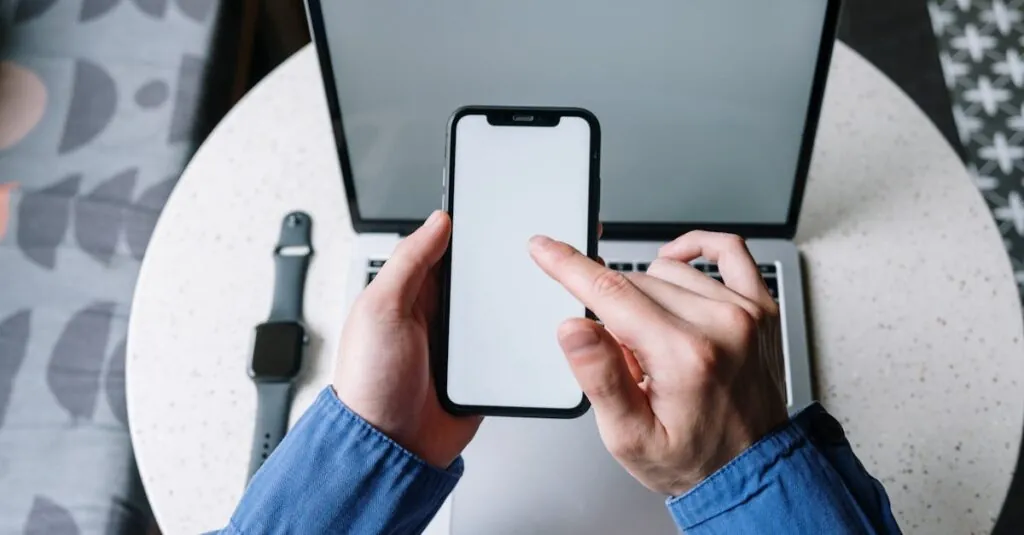In a world where streaming and downloading videos is as common as scrolling through social media, finding a way to watch MPEG files on an iPhone can feel like trying to find a unicorn in a haystack. But fear not! Just because Apple’s beloved device doesn’t natively support MPEG doesn’t mean you’re destined to miss out on your favorite clips.
Table of Contents
ToggleUnderstanding MPEG File Formats
MPEG files are widely used for video and audio compression. Users encounter these files in various media applications, making it important to understand their characteristics.
What Are MPEG Files?
MPEG stands for Moving Picture Experts Group, an organization responsible for standardizing digital video and audio compression methods. This format reduces file sizes while maintaining acceptable quality. MPEG files typically feature extensions like .mpg and .mpeg, allowing for efficient storage and transmission. Due to their wide compatibility, they often appear in video streaming and broadcasting.
Types of MPEG Formats
Several MPEG formats exist, each serving different purposes. MPEG-1 offers basic video quality, suitable for early digital video systems. MPEG-2 enhances video quality, commonly used for DVDs and broadcasting. MPEG-4 features advanced compression techniques, making it ideal for streaming over the internet. Each type balances quality and file size, catering to various viewing needs and device capabilities.
Built-In iPhone Capabilities
iPhones come equipped with features that facilitate video playback, providing users with multiple options to watch their videos.
Default Video Player
The default video player on an iPhone is the Apple TV app. This app supports various formats and provides easy access to videos stored on the device. Users can also play videos directly from the Photos app, which organizes and displays video files automatically. When it comes to MPEG files, the Apple TV app may not recognize them unless they are converted to a compatible format.
Supported Formats
Supported formats on an iPhone include MOV, MP4, and M4V. These formats ensure seamless playback across all iOS devices. While MPEG files aren’t natively supported, converting MPEG files to one of these formats allows for smooth viewing. Video files compressed in MPEG-4 format fit well within iPhone capabilities, maintaining quality while minimizing file size. By focusing on compatible formats, users can enhance their video playback experience effectively.
Third-Party Apps for MPEG Playback
Various third-party apps provide efficient solutions for playing MPEG files on iPhones. These applications often support a wider range of formats and ensure a smooth viewing experience.
Recommended Video Players
VLC Media Player stands out as a popular choice for MPEG playback. It supports numerous formats, including MPEG-1, MPEG-2, and MPEG-4. Infuse offers advanced options for streaming and handling different media formats. Another good option is PlayerXtreme, which provides a user-friendly interface and broad format compatibility. MPC-HC serves well for those looking for lightweight functionality. Each player brings unique features tailored to enhance video enjoyment.
How to Install and Use These Apps
To begin installation, visit the App Store on your iPhone. Search for VLC Media Player and tap ‘Get’ to start the download. After installation, open the app and use its intuitive interface to navigate to your MPEG files. For Infuse, the steps are similar; download it, launch the app, and import your videos. PlayerXtreme also follows this straightforward procedure, making it user-friendly. Explore built-in features to customize playback according to personal preferences.
Transcoding MPEG Files for iPhone
Transcoding MPEG files allows iPhone users to enjoy video content effortlessly. While iPhones don’t support MPEG formats natively, converting these files into compatible alternatives ensures smooth playback.
Best Software for Conversion
HandBrake stands out as a top choice for converting MPEG files. This open-source software provides users with customizable settings for efficient transcoding. Additionally, Any Video Converter is user-friendly and supports a variety of output formats. For those seeking an all-in-one solution, Wondershare UniConverter offers powerful features and a straightforward interface. Each application simplifies the transition from MPEG to iPhone-friendly formats like MP4.
Step-by-Step Conversion Process
First, download and install the chosen software on your computer. Next, open the software and import the MPEG files by dragging and dropping them into the workspace. Select the desired output format, typically MP4 for iPhones. Adjust quality settings if needed to maintain video fidelity. Finally, click the convert button to initiate encoding, and save the new files. After conversion, transfer the videos to the iPhone using iTunes or cloud services, ensuring accessible playback on the device.
Watching MPEG files on an iPhone isn’t as complicated as it may seem. With the right tools and methods users can easily enjoy their favorite videos without hassle. Whether opting for third-party apps or converting files to compatible formats the options available ensure a smooth viewing experience.
By utilizing apps like VLC Media Player or Infuse users can bypass the limitations of the default video player. For those who prefer transcoding HandBrake and Any Video Converter offer effective solutions to convert MPEG files into formats that iPhones support.
With these strategies in hand anyone can unlock the potential of their video library and enjoy MPEG content on their iPhone effortlessly.



